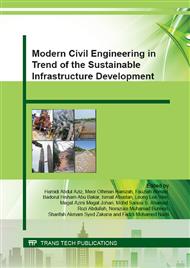p.425
p.431
p.437
p.443
p.448
p.454
p.460
p.466
p.472
Influence of Hydraulic Conductivity and Organic Matter Content in Different Bioretention Media on Nutrient Removal
Abstract:
Bioretention media composition plays an important role in maintaining hydraulic conductivity within appropriate range and treating stormwater runoff to reduce pollution to receiving water bodies. This study investigated 4 types of bioretention media, 2 of which different types of compost and another 2 using shredded newspaper and crushed cockle shell as additives to modify the bioretention media. The objective of the study was to provide insight on hydraulic performance and media characteristics that control bioretention stormwater treatment performance. Results showed that organic matter content has no effect on hydraulic conductivity and nutrient removal performance of the media. Comparison of hydraulic conductivity and nutrient removal showed that reduced hydraulic conductivity (from 250mm/hr to 159mm/hr) increased total suspended solids (TSS) removal of the media (up to 98.5%) but has no effect on total nitrogen (TN) and total phosphorus (TP). The preliminary pollutant test using natural runoff showed that bioretention media enhanced with 10% shredded newspaper performed the best in TN removal (up to 85.3%) and bioretention media enhanced with 10% crushed cockle shell removed the most TP (up to 95.6%).
Info:
Periodical:
Pages:
448-453
Citation:
Online since:
October 2015
Authors:
Price:
Сopyright:
© 2015 Trans Tech Publications Ltd. All Rights Reserved
Share:
Citation:


